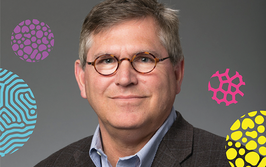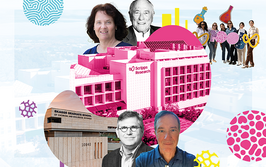Landmark Literature: 2015 (part3)
Selecting “the paper of the year” is by definition subjective and very personal.

Practically and Fundamentally Excellent
By Peter Schoenmakers, Education Director COAST; Editor, Journal of Chromatography A; Professor, Analytical Chemistry/Forensic Science, University of Amsterdam, The Netherlands
A recent paper by Fabrice Gritti, Thomas McDonald and Martin Gilar struck me for several reasons. Firstly, it is an immensely important publication for liquid chromatographers. Such steadfast folk tend to strive for high efficiencies and excellent separations by making or using better columns with very small and uniform particles, perfectly homogeneous monoliths, and so on. But, unfortunately, they forget that long or poorly designed connectors and extra-column apparatus cause them to lose what they aim to gain – a problem the paper attempts to correct. In addition, the paper describes ingenious and original methods. It is a practical liquid chromatography (LC) paper, with theory supporting the experiments that aim to capture the causes of “misdemeanors” by short pieces of connection tubing. The results from the tedious experiments are consistent and rather surprising, the latter being mandatory for an interesting paper.
The paper contains some recommendations that will not surprise you, such as using the narrowest possible tubing and elevated temperatures, and voices a suggestion that we hear with increasing frequency, “Shouldn’t we all convert to supercritical-fluid chromatography (SFC)?” When we replace conventional water-acetonitrile mixtures in LC with mixtures of carbon dioxide and methanol for SFC, it is possible to perform faster separations (which we already know) and extra-column band broadening may be less of a threat (which is more remarkable than it seems – see SFC Star). Therefore, it will be interesting to see whether SFC will begin to catch up with LC. SFC has fundamental properties on its side (faster diffusion, lower viscosity), but aqueous-organic mixtures have proven to be fantastic eluents for all kinds of samples.
There is another reason why this paper is important for the entire chromatographic community. Something – or rather somebody – is missing. Fabrice Gritti published more than 200 papers together with Georges Guiochon in just over a decade. We do miss Georges (who passed away in 2014), but his absence is not felt when reading this paper because it contains excellent science – something we need to see more regularly. Indeed, I shall try to motivate my students to embark on these kind of studies. I suggest that you take note of the experiments shown in Figures 2 and 3, which take between a few seconds and six minutes.
There are many experiments in this study (30 or more different flow rates, quintuple injections and several different configurations), but the total net measuring time is just a few days. One instrument could produce a hundred papers per year, which seems like a dream to academicians like me – but a nightmare for the authors’ employers! However, it needs a very special kind of instrument. When someone submits a manuscript to Journal of Chromatography A describing the use of “a virtually dispersion-less instrument”, we ask the authors to control their fantasies. Unless it is Fabrice Gritti! His approach to science – after serving an exceptional apprenticeship – is virtually flawless.
Peter’s Landmark Paper
F Gritti et al., “Accurate measurement of dispersion data through short and narrow tubes used in very high-pressure liquid chromatography”, J Chromatogr A, 1410, pp. 118–128 (2015). PMID: 26255113.
Go with the Flow (Field)
By Pat Sandra, Emeritus Professor, Organic Chemistry, Ghent University; Founder and President, Research Institute for Chromatography, Kortrijk, Belgium.
Selecting “the paper of the year” is by definition subjective and very personal. Moreover, it depends on your own fields of interest in a given period and on the journals that you have consulted. This year, I have read many good publications particularly those on chromatographic and mass spectrometric topics. A couple of papers related to my first love – capillary gas chromatography (CGC) – struck me the most. CGC is a mature technique and, in recent years, the developments have been linked to pre- or post- column hyphenation, for example, automated sample preparation and high-end mass spectrometers, respectively.
Had I been asked to name “the paper of the year” before the 2015 summer holiday period, my answer would have been undoubtedly: “Evaluation of conditions of comprehensive two-dimensional gas chromatography that yield a near-theoretical maximum in peak capacity gain” by Matthew Klee et al. (1). The paper combines a very sound theoretical basis with a high practical impact for GC×GC users. However, in August (with a gin and tonic in my hand… I’m an emeritus professor after all), I read: “Flow field thermal gradient gas chromatography” by Peter Boeker and Jan Leppert. As is typical for me when reading articles, my attention was drawn by the chromatograms with peak capacities over 200 in less than one minute.
For more than 60 years, analytical scientists have known that a negative temperature gradient in the direction of the gaseous mobile phase can offer interesting features. The suppression of chromatographic dilution or solute focusing – resulting in increased sensitivity for trace analysis – was mentioned by Schuchowitzkij and Turbeltaub in 1957 (2, the original publication was in Russian and also featured a book: “Some Developments in Gas Chromatography in the USSR”, Butterworths, London, 1960). Over the years, several well-known researchers were active in this field; John Phillips (the inventor of GC×GC) and Leonid Blumberg (the “Giddings” of CGC theory), for example, and it’s quite interesting to read their controversial discussions. More recently, the Lee group (Brigham Young University, Provo, Utah, USA) developed different technical approaches to perform negative thermal gradient CGC and, through many lectures at international symposia, rekindled interest in the subject.
The ingenuity of Boeker and Leppert’s concept lies in correctly estimating the importance of heat loss due to convection. Flow field thermal gradient gas chromatography (FF-TG-GC) is based on the precise control of the convective heat loss from a heated capillary. They demonstrated their concept by producing a temperature gradient using a cooling gradient flow field generated by a pressure drop inside a tube with a helical channel (in which the separation column is positioned and resistively heated) packed with porous material. The pressurized air in the tube flows through the porous material and exits through the helical channel. The flow decreases as the flow path increases, resulting in a smooth decreasing flow from the bottom (detector side) to the top (injector side). This results in a negative temperature gradient with a direction from injector to detector, which can be adjusted by varying the gradient fan. Without activating the gradient fan, a conventional temperature programmed analysis is obtained. For readers interested in the fundamentals we refer to the original paper (2). Now, I’d like to emphasize some features and future perspectives of FF-TG-GC.
The first observation is that all separations shown, with or without off-TG, are excellent and illustrate clearly the present state-of-the-art in CGC. Peak capacities around 200, with peak production rates (peak/min) of ca. 400 (heating rate 70°C/s) are obtained with the set-up described in the article. The gain in peak capacity and in peak sharpness (focusing) with FF-TG is only around 5 percent, but the same solute elutes at a substantially lower temperature in FF-TG. As an example, for C28 the reduction is 45°C or when translated to C24 and C30 the solutes elute at the same temperature without FF-TG and with FF-TG, respectively. This offers possibilities for high-temperature GC (for example, simulated distillation) or separation at much lower temperatures for thermolabile compounds. In the paper, this is shown for explosives and natural pyrethrins. The authors mention that future improvements will include using hydrogen as the carrier gas, working in the constant flow mode, injection via a programmed temperature vaporizer, and so on. Application as second dimension column in GC×GC is another possibility. In addition, I can see features for sequential GC or continuous heart-cutting GC. This should create peak capacities that are impossible to obtain in conventional GC×GC! Taking the optimized, first dimension column (60 m x 0.25 mm), and temperature programming time (80 min) described by Klee (1), together with 30s sequential heart-cutting using a FF-TG set-up with high peak production rate, it should give a much higher total peak capacity compared with the 4500 in optimized GC×GC – and in the same amount of time. I think it is very worthwhile following this development.
Pat’s Landmark Paper
P Boeker and J Leppert, “Flow field thermal gradient gas chromatography”, Anal Chem 87, 9033–9041, (2015). PMID: 26235451.
Martin Gilar talks about his Landmark Paper
Peter Griffiths talks about his Landmark Paper
- MS Klee et al., “Evaluation of conditions of comprehensive two-dimensional gas chromatography that yield a near-theoretical maximum in peak capacity gain”, J Chromatogr A, 1383, 151–159 (2015). PMID: 25627969. AA Schuchowitzkij and NM Turkeltaub, Dokl. Akad. Nauk SSSR116, 986 (1957).
Pat Sandra is Emeritus Professor of Organic Chemistry at Ghent University, and Founder and President of the Research Institute for Chromatography (RIC), Kortrijk, Belgium. “Through the activities of RIC, I got in touch with the real analytical needs of the industry and found we could help in providing solutions that are economically relevant. Moreover, it allowed me to keep my best PhD students around me, which resulted in high scientific output in a non-academic environment,” he says.
Peter is education director COAST; editor, Journal of Chromatography A; and, professor, Analytical Chemistry/Forensic Science, van't Hoff Institute for Molecular Sciences, University of Amsterdam, The Netherlands.

















